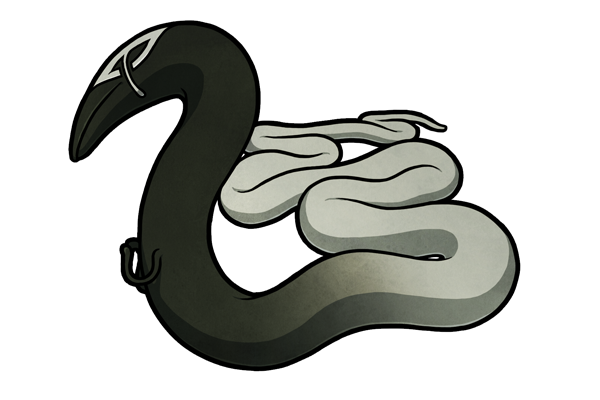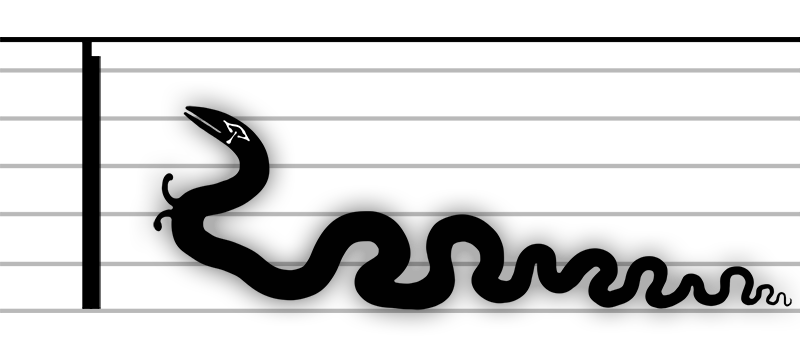

drasorome
the Calendar-Barons
prefix draso suffix rome
slandrous tellmonth
physical appearance
The drasorome /dɹeɪzəˈɹoʊm/ is a "masked" stranger with stunted, fingerless arms, and a serpentine body that transitions from charcoal black to light grey. Its flesh is composed of chlorinium dichlorihyde (and thus bears identical properties), and as such, the stranger bears only a strongly bitter odor at close range.
The drasorome's voice sounds like the soft but rhythmic grinding of leather against stone.
the sounds of organic dragging.

environment, generation, and relationship to the calendar
The drasorome has no environmental preferences. The locus of infestation can range from a just-out-of-business carpet store, the bottom floor of a truck garage, the top floor of a condensed-office building, or along the barren highway-side. It starts off as a tiny, maskless worm, which tries to "tunnel" underground, each downward push of its head only making its body grow longer and larger. Its incipient nature is marked by dismay and fear, though it seeks shelter and grows more somber as it matures. It is once its mask fades into view that the drasorome attains its adult disposition, and slips confidently into the darkness.
behaviour and effects
The drasorome displays a covert and sneaky personality. It moves in cobra-like advances and withes, its ribbon-limbs limp, but never snagging. Receding from all but the most direct attention, the stranger avoids both noise and light. It is most at home in gaps just outside the line of sight, finding comfort in the obstruction of a tabletop, or the guard given by a low shelf.
The strain keeps a wide and meandering territory, and, as the month goes on, more and more individual territories begin to overlap. Though not asocial, interactions between drasorome are brief; the pair might "sniff" each other, or entwine their arms for a second or two. In all interactions, there seems to be a randomized, but slight power dichotomy, with the "lesser" of the two individuals head down, as though vaguely shamed, though the non-lesser displays no sense of superiority.
It does not rest, let alone build nests, nor does it restrict itself to any particular territory type in its stealthy and incessant wander. Because of its chlorinium dichlorihyde body, the drasorome can squeeze through any hole as wide as its arm, and its otherwise limp limbs grow (somewhat) stiff as needed in order to test particularly suspect crevices. Aside from a dark ring around the rim of narrow entrances, the drasorome tends to leave few indicators of its presence.
inability to move backwards and effect upon the groundwater
The drasorome is unable to move backwards. When it reaches a dead end and cannot turn around, its body stops, and it seems to grow sick and die. The corpse of a "trapped" drasorome turns inanimate, and its flesh (particularly, its mask) begin to bubble at a constant and exaggerated rate.
Unlike other drasorome corpses, "trapped" drasorome corpses do not disappear at the end of the month, and instead remain active for up to one hundred and eighty years. The by-products of a single individual can contaminate at least a city block, with plants no longer taking seed, and insects no longer teeming, to say nothing of the increase in neurological disorders, cancer, and cardiac arrest in the civilian population remaining in the area.
mining of "trapped" corpses
Because of their chlorinium dichlorihyde bodies, the corpses of "trapped" drasorome are mined by underground drug manufacturers during the hoping to create their own batches of psycholy, rather than rely on costly materials smuggled from government-owned labs. Though these "bootleg" cores tend to produce only five to six full-batchesქ before the corpse becomes too caustic and contaminated to handle, they nonetheless deliver a considerable number of drug cycles (perfect and imperfect alike) to the underground scenes.
ქ A "full-batch" of psycholy consisting of 20,000 gel tabs.
pursuit and interactions with sensitives
The drasorome spends much of its time in direct pursuit of sensitives, though it does so in a manner so stealthy that it is nearly impossible to track. Though it will become impeded by the end of the sociospace field or any impassible physical barrier.ᴦ
ᴦ As occurs when the drasorome tracks a sensitive 'behind' the safety of a brick wall, only to reach a dead end; a fatal outcome for the strain.
Despite its draw towards sensitives, the drasorome is dispelled with even mild interaction on the sensitive's behalf. If pursued (and particularly if attacked), it retreats to safety as best it can, and moves out of sight until the sensitive𐅘 has lost interest and left the area.
𐅘
Notes for the week:
Check back staircase lock.
Check mirrors - don't let it touch you.
Pick up food, lightbulb, fishhook.
Check monitor.
Release new entry.
Check paths 3-12.
Check back staircase lock.
Check mirrors - don't let it touch you.
Pick up food, lightbulb, fishhook.
Check monitor.
Release new entry.
Check paths 3-12.
If unnoticed by the sensitive, the drasorome sneaks closer and closer, until it can tap the sensitive on the shoulder. Its touch is light, but pervasive. The stranger's effect moves through clothes (and many costumes), but not a backpack, nor a blanket, and it permeates bare flesh without fail. This effect causes the infrequent sensation of chewing on a loosened tooth in the right back molar. As long as one is focusing on the possibility of that sensation, it is staved off. Should the mind wander, though, the grind recurs. The tooth also feels more or less "loose" depending on proximity to any drasorome within a ten mile radius.
Though the first day of the new month brings respite from the symptoms, 10% of victims end up "losing" the tooth regardless.
aging and death
The drasorome's month-long infestation peaks at the final day of the month, upon which all individuals die before midnight of that time zone. One-by-one, each drasorome's body shrivels up, sucked inward by some hungry force, leaving behind only a translucent, dried-up husk.₣ This meager remainder, however, does not persist more than five to ten minutes, before even this shell blinks from existence.
₣ Research into the mechanisms involved in this death process helps lead to the later extraction of psycholy (among other substances) from chlorinium dichlorihyde.
Following a drasorome outbreak, it can be hundreds of years before the strain shows up again in an affected city.



